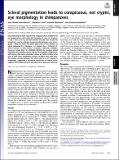Scleral pigmentation leads to conspicuous, not cryptic, eye morphology in chimpanzees
Date
03/09/2019Metadata
Show full item recordAbstract
Gaze following has been argued to be uniquely human, facilitated by our depigmented, white sclera [M. Tomasello, B. Hare, H. Lehmann, J. Call, J. Hum. Evol. 52, 314–320 (2007)]—the pale area around the colored iris—and to underpin human-specific behaviors such as language. Today, we know that great apes show diverse patterns of scleral coloration [J. A. Mayhew, J. C. Gómez, Am. J. Primatol. 77, 869–877 (2015); J. O. Perea García, T. Grenzner, G. Hešková, P. Mitkidis, Commun. Integr. Biol. 10, e1264545 (2016)]. We compare scleral coloration and its relative contrast with the iris in bonobos, chimpanzees, and humans. Like humans, bonobos’ sclerae are lighter relative to the color of their irises; chimpanzee sclerae are darker than their irises. The relative contrast between the sclera and iris in all 3 species is comparable, suggesting a perceptual mechanism to explain recent evidence that nonhuman great apes also rely on gaze as a social cue.
Citation
Perea-García , J O , Kret , M E , Monteiro , A & Hobaiter , C 2019 , ' Scleral pigmentation leads to conspicuous, not cryptic, eye morphology in chimpanzees ' , Proceedings of the National Academy of Sciences of the United States of America , vol. Latest Articles , 201911410 . https://doi.org/10.1073/pnas.1911410116
Publication
Proceedings of the National Academy of Sciences of the United States of America
Status
Peer reviewed
ISSN
0027-8424Type
Journal article
Collections
Items in the St Andrews Research Repository are protected by copyright, with all rights reserved, unless otherwise indicated.

